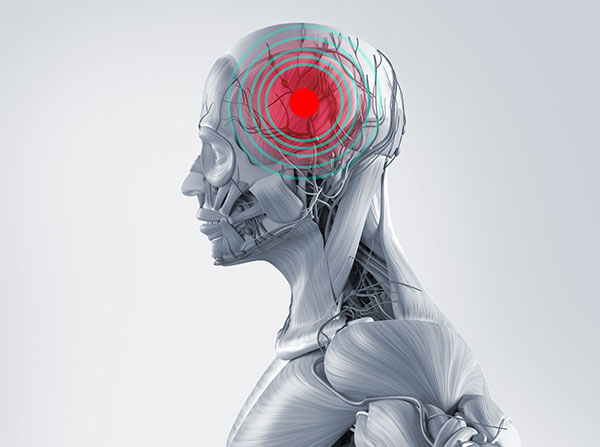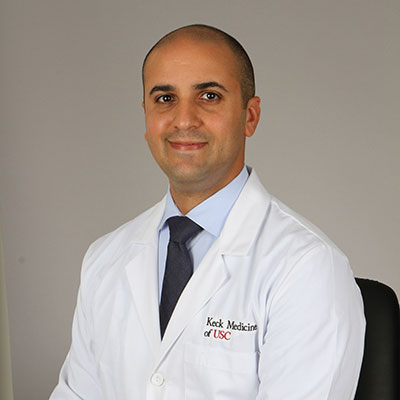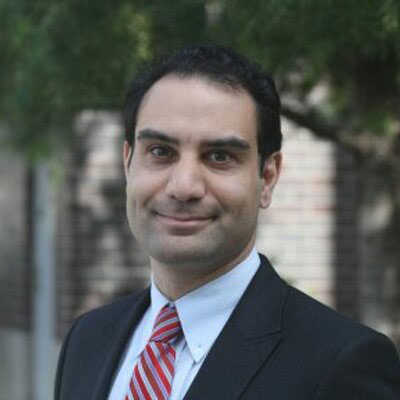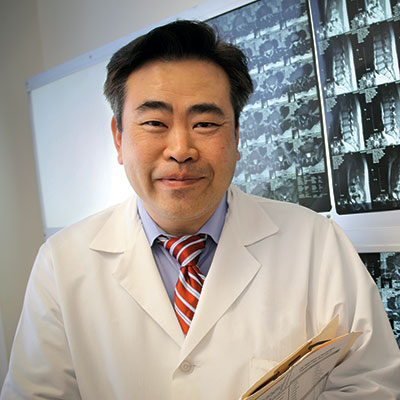
Of the dozens of clinical trials being conducted at the USC Norris Comprehensive Cancer Center at any given time, there is one in particular that has Naveed Wagle, MD, director of the USC Brain Tumor Center at USC Norris, filled with anticipation. Every new clinical trial provides hope for his patients, but this one is unusual because it is testing a type of chemotherapy that is a first in its class.
The trial is testing a new chemotherapy for patients with gliomas, which account for about 80 percent of all malignant brain tumors. What makes this drug unusual is that it is inhaled, using a mask that covers the nose, and it delivers the drug to the brain by way of the olfactory and cranial nerves. If successful, this novel delivery system may solve one of the problems that has hindered effective treatment of brain cancer.
Chemotherapy has always been harder to administer for brain cancer patients because it requires heavy doses to pass through the blood brain barrier, which protects the brain from toxins. Those heavy doses make tolerating treatment more difficult for most patients and can lead to systemic toxicity.
Another unusual feature of this type of chemotherapy is that whatever is not used by the body to treat the tumor, will be exhaled. The hope is that the chemotherapy may be more effective at attacking tumors when inhaled and the patient will experience fewer side effects and have a better quality of life through their treatment.
New Treatments, More Options
Because of their location, brain tumors have always posed challenges to treatment that doctors have long struggled to overcome. Surgery has been risky because extracting the tumors can permanently damage the brain and alter the patient’s ability to function in the world.
Physicians really need new options in order to give brain cancer patients and their doctors what they have long wanted: better treatments to improve survival rates and improve the quality of life for survivors. That is why the team at the USC Brain Tumor Center has been pushing to find novel solutions, such as leading the clinical trial on the inhaled chemotherapy. The multidisciplinary team at the USC Norris Comprehensive Cancer Center has a long history of adopting leading edge treatments, such as gamma knife, to improve both survival rates and quality of life.They have adopted many new techniques in recent years that are not widely offered.

Gabriel Zada, MD
“We are a leading center in California for minimally-invasive brain surgery,” says Gabriel Zada, MD, director of the USC Endoscopic Skull Base Surgery program. “There are only a couple of academic medical centers that can do these types of surgery.”
USC Norris’s surgeons are also among the most experienced at utilizing minimally invasive techniques for operating on brain tumors. By inserting an endoscope into the nose, surgeons can now remove tumors near the base of the skull, an area had once been difficult to access. Using small, lighted instruments, surgeons can remove even large tumors using this technique, which also reduces the recovery time for patients.
Likewise, the surgeons at USC Norris have also adopted new approaches, such as entering the brain through a tiny incision in the eyebrow. This approach is useful for patients with tumors near the optic nerves or pituitary gland, as well as gliomas and metastatic brain tumors in the frontal lobe. The team at USC Norris was also one of the first training centers for medical residents in BrainPath exoscopic channel surgery, which allows surgeons to remove tumors deep in the brain by navigating between the folds of the brain to minimize damage.
These minimally-invasive approaches require only small incisions, which reduces potential damage to the brain and the nerves, preserving brain function and also lessening the time they spend recovering from surgery.
Advances in surgery for complex tumors
Even when using the latest tools and minimally-invasive techniques, operating on the brain is a delicate procedure. It has to be done well or it can risk that patient’s quality of life. The USC Norris team brings extensive experience to these techniques, offering patients the highest chance for success.
Zada added that the team has also pioneered the use of advanced imaging techniques and high performance dyes to help them more effectively target the tumors and minimize damage to the brain.
Not all tumors can be removed through these techniques and still require the surgeons perform craniotomies, which involves removing part of the skull. Even when it comes to craniotomies, USC Norris can offer advanced techniques. It is one of the few centers where doctors regularly perform awake craniotomies —a technique not widely available because it requires highly-specialized anesthesiologists, advanced imaging equipment and high performance dyes.
Keeping the patient awake helps guide the surgeons, helping them to understand if they are moving into an area of the brain that may affect the patient’s speech or motor function. Zada says the advances have made it possible for surgeons to remove complex tumors that in previous years would have been considered inoperable and to do so more safely.
“Patients experience fewer neurological deficits and we see improved quality of life for longer now,” says Zada.
Getting the best treatment to the right patient
Often, patients require chemotherapy to halt the growth of the tumor or to prevent the spread of the disease. With many types of cancer, choosing the effective chemotherapy had been an exercise in trial and error. But trial and error is never the best option for patients, and especially for brain cancer patients because of the risk of toxicity.

Naveed Wagle, MD
In an effort to choose the best chemotherapy the first time, the team at USC Norris has adopted genetic testing on all brain tumors, which helps the doctors choose the type of chemotherapy that is going to be most effective for that patient’s particularly type of cancer.
There are more than 100 distinct types of brain and central nervous system tumors and genetic testing provides useful information about each tumor’s mutations. This information helps the doctors come up with a plan, choosing the drug that has the most potential to stop the tumor or it may make a patient a candidate to participate in a clinical trial.
USC Norris currently has one clinical trial underway targeting a specific genetic mutation found in some malignant brain tumors. The trial is focused on the MGMT gene, which can allow cancer cells to avoid traditional chemotherapy, and tests a new drug combination that blocks this mutation to allow existing chemotherapy more effectively fight against these tumors. A second trial aimed at finding effective treatments against malignant brain tumors with a genetic mutation of the EGFR amplification gene, is set to begin in the summer of 2016.
Wagle adds that plans are already in the works for several more clinical trials in the near future. On the horizon, says Wagle, is a pair of trials for immunotherapy drugs, which harness the power of the body’s immune system to fight the cancer. Though immunotherapies are on the market for other types of cancer, it was long believed that immunotherapy drugs, much like chemotherapy drugs, would not pass the blood-brain barrier. But new delivery systems for immunotherapy drugs are also on the horizon.
Attacking Brain Cancer on Every Front

Thomas Chen, MD, PhD
Thomas Chen, MD, PhD, professor of neurosurgery at the Keck School of Medicine of USC, explains that the team at USC Norris has committed to attacking brain cancer on every front. “We are putting all our effort into looking for the next big breakthrough for brain cancer,” says Chen. “We are looking at many possible new advances right now. We are testing better delivery methods for drugs. We are looking at combining different treatments in an effort to find more effective therapies.”
Chen says that, the way he sees it, it is his job to provide the best medical treatment possible and to provide them with hope for their future. He believes the best way to deliver hope is to let his patients know they are in the hands of a team of doctors, nurses, social workers, geneticists who are pushing boundaries by adopting cuttingedge treatments and doing the research that just might lead to the next major advance in the treatment of brain cancer.
by Hope Hamashige